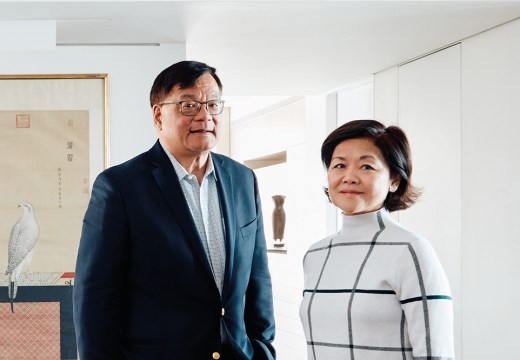From the March 2023 issue of Apollo. Preview and subscribe here.
After a one-off opening in June last year, the European Fine Art Fair (TEFAF) returns to Maastricht this month as usual. Some 270 galleries and dealers in art and antiques bring the best of their wares to the Maastricht Exhibition & Conference Centre (MECC) from 11–19 March. Thirteen of the exhibitors will be first-time dealers and ten newly established galleries will be joining the Showcase section this year. Here, Susan Moore selects her highlights from the work on display at the fair.

Bodhisattva (c. 1000–1050 AD) Newar artists in Central Tibet. Rossi & Rossi, $10m
Bodhisattva (c. 1000–1050 AD), Newar artists in Central Tibet
Rossi & Rossi, $10m
Large-scale images of Hindu deities are rare in Nepalese metalwork. This early figure is closely related to the sculpture of the androgynous god Ardhanarishvara in the Los Angeles County Museum of Art. Both were probably intended as principal icons in a shrine, conceived as freestanding figures but probably not intended to be viewed in the round. This figure bears no attributes, but the god’s hands may well have once held lotus flowers, suggesting an identification with the sun god Surya. It was acquired by Leonidas Goulandris in 1973, before passing to George Ortiz in 1996.

Wine vessel (jiao), late Shang dynasty (c. 1300–1046 BC),China. Gisèle Croës, €480,000
Wine vessel (jiao) (China, late Shang dynasty; c. 1300–1046 BC)
Gisèle Croës, €480,000
Jiao are among the rarest and most ancient types of Chinese ritual bronze vessels, used to hold libations for the veneration of ancestors and displayed in ancestral halls or temples before being buried in tombs for use in the afterlife. This tripod vessel bears characteristic geometric and anthropomorphic ornamentation, including taotie animal masks with round protruding eyes. Its semicircular handle bisects one of the taotie, ingeniously serving as a nasal bridge and widening to form a bovine head. Another is formed under a protruding ram’s head whose pointed ears and wide, stylised horns blend into the triangular masks under the wings.

Head of a Young Man, Roman, Mid 2nd century AD. Colnaghi, price on application
Head of a Young Man (Roman, Mid 2nd century AD) Marble
Colnaghi, price on application
Portraiture in the Imperial period took its cue from official portraits of the emperor. Hadrian forsook the close-cropped hair and shaved faces of his predecessors, choosing instead to be depicted bearded and with longer, wavy hair. Under the emperors of the Antonine period, hair became longer still and curlier, with exuberant sculpted curls often achieved with a running drill while beard and moustache, and lips, are delicately carved, as here. Despite its losses, this head of a gently smiling young man is remarkably well preserved and has no restorations.

Tritons and Nereids (c.1520), Amico Aspertini. Day & Faber, €430,000
Tritons and Nereids (c. 1520) Amico Aspertini
Day & Faber, €430,000
Striking for its scale, ambition and state of preservation, this highly finished presentation drawing reflects the passion for Roman antiquity among the courtly and intellectual elite of Bologna in the Renaissance. Vasari described Aspertini as ‘an eccentric and singular person’ and his work as ‘extravagant’. The artist’s sketchbooks reveal studies of Roman sculpture and architectural detail as well as real and half-imagined scenes and fantastical creatures. This grisaille might relate to monochrome frescoes, now lost, painted on the walls of the Palazzo Marsili in Bologna and only three other comparable drawings are known.

Portrait of a Scholar (c. 1545) Jacopo Tintoretto. Trinity Fine Art, price on application
Portrait of a Scholar (c. 1545), Jacopo Tintoretto
Trinity Fine Art, price on application
First recorded in the famous collection of the painter Peter Lely, and later at Eastnor Castle, this rediscovered portrait reveals the young Venetian artist responding to the bold innovations in portraiture heralded by Titian in his Portrait of Pietro Aretino (1545). Perhaps in rivalry, Tintoretto nods to the master’s sketchy handling of his sitter’s costume while also devoting great care and attention to producing a psychologically astute and expressive head. The young man turning to direct his gaze towards us wears a fur-trimmed zimarra, a long heavy coat commonly worn indoors in winter. A copy exists, possibly by the artist’s son Domenico.

Canning Reliquary pendant (c. 1570), probably French. Kugel, price on application
Canning Reliquary pendant (c. 1570)
Kugel, price on application
Canning family tradition has it that this bejewelled reliquary was a gift of Catherine of Braganza, wife of Charles II. First published in 1801, it was described as originally housing a relic of the True Cross, the narwhal horn of its cylinder (now faux-narwhal) replacing the presumed rock-crystal original. The geometric patterns of the vivid enamel decoration are characteristic of Parisian production of the 1570s, and appear on a pedant commissioned by Catherine de’ Medici in 1571. Latterly in the collection of the American banker Robert Lehmann, the piece was long on loan to the Metropolitan Museum of Art in New York.

Lantern tankard (c. 1635) Michael Müllner. Kunstkammer Georg Laue, €240,000
Lantern tankard (c. 1635), Michael Müllner
Kunstkammer Georg Laue, €240,000
Müllner was a highly successful Nuremberg goldsmith who played a leading role in the revival of the gothic style in the 17th century. This cylindrical lidded vessel, whose small door opens to reveal a painted burning candle, takes the form of a dark lantern. Such vessels were used during festivities as a sign of departure. The host would present the silver lantern to his guest for the last drink of the evening, a reference to the custom of escorting guests out onto the street with light. The tankard features in a thematic exhibition and accompanying publication, Drinking Games in Silver for the European Courts.

Philoctetes on the Island of Lemnos (1647), Gerard van Kuijl. Haboldt & Co., €650,000
Philoctetes on the Island of Lemnos (1647), Gerard van Kuijl
Haboldt & Co., €650,000
The enigmatic Gerard van Kuijl trained in the studio of Gerrit van Honthorst in Utrecht before arriving in Rome around 1628–29 where he was influenced by the prevailing classicism as much as the legacy of Caravaggio. His subject, exceedingly rare in both Italian and Northern art, depicts the solitary hero on the island of Lemnos, abandoned by the Greek army en route to Troy after a wound on his foot became infected. Beside him are the famous bow and arrows given him by Herakles. The painting belonged to Benedict Nicolson, the pioneering scholar of the international Caravaggesque movement.

Demilune commode (c. 1820–21) Carlo Randoni .Burzio, price on application
Demilune commode (c. 1820–21), Carlo Randoni
Burzio, price on application
In 1819, Vittorio Emanuele I and Maria Teresa of Savoy acquired the Palazzo Tursi in Genoa for their principal residence, commissioning designs for its white and gold Empire furniture from court architect Carlo Randoni. Signed designs for four pieces survive, including the plan and elevation for this commode and its pair, the latter at Attingham Park in Shropshire (with a later Carrara marble top in contrast to the original pink and gold Spanish brocatello here).The chests’ foliate sprays, ribbon-tied garlands of leaves and berries, and quivers of arrows or torches, were probably carved by sculptor Giovan Battista Parodi.

Jeune fille à la coquille (c. 1864) Jean-Baptiste Carpeaux. Daniel Katz Gallery, £550,000
Jeune fille à la coquille (c. 1864), Jean-Baptiste Carpeaux
Daniel Katz Gallery, £550,000
Research in the archives of the Musée d’Orsay suggests that this sculpture is the piece Carpeaux exhibited at the Paris Salon in 1864, subsequently presented alongside its plaster pendant, Le pecheur à la coquille. While her pose alludes to classical prototypes, Carpeaux’s life-size girl crouching on an overturned wicker basket of fish is no Venus. Decidedly modern and playful, she places a large conch shell on her head as if it were a modish hat. The model was almost certainly Anna Foucart, whose father, a Valenciennes lawyer who was the sculptor’s friend and patron. The popular figure was also produced in terracotta, marble and bronze.

Femme au Tablier (1949) Pablo Picasso. Thomas Gibson Fine Art, price on application
Femme au Tablier (1949), Pablo Picasso
Thomas Gibson Fine Art, price on application
Picasso painted over a trial proof of his lithograph Femme aux cheveux verts, one of a series of images of his muse and fellow artist Françoise Gilot prompted by Matisse’s declaration that if he were ever to paint Gilot’s portrait, he would give her leaf-green hair and a pale blue body. The ever-competitive Picasso got there first, executing La femme-fleur in 1946. Here, the black lines over the green allude to both the veins of the leaves and also the web of the hairnet used to sweep back the sitter’s mane of thick dark hair.
Mezza-Filigrana Bianca-Nera vases (1954), Dino Martens
Marc Heiremans, €5,000–€12,000
Venetian painter Dino Martens became artistic director of the glass firm Vetreria Aureliano Toso in 1939, transforming the company through the inventiveness and experimentation of its bold new productions. Towards the end of his life, the dazzling colour and wildly biomorphic forms that characterised Martens’ earlier designs gave way to more refined shapes and subtle chromatic effects. The Mezza-Filigrana Bianca-Nera series of blown glass incorporates black and white bands of fused glass canes – their only touch of colour provided by the aventurina canes bordering these spirals. This group includes the most eccentric – and rarest – shapes.
TEFAF Maastricht is at the MECC, Maastricht, from 11–19 March. For more details, go to tefaf.com.
From the March 2023 issue of Apollo. Preview and subscribe here.
Unlimited access from just $16 every 3 months
Subscribe to get unlimited and exclusive access to the top art stories, interviews and exhibition reviews.














![Masterpiece [Re]discovery 2022. Photo: Ben Fisher Photography, courtesy of Masterpiece London](http://www.apollo-magazine.com/wp-content/uploads/2022/07/MPL2022_4263.jpg)
It’s time for the government of London to return to its rightful home